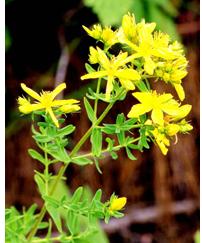
St. John's wort
1 Descriptions and Specifications of Product
Content Specifications: 0.3% Hypericin by UV
3.0% Hyperforin by HPLC
2 St. John's wort (Hypericum perforatum in Latin) is a long-living plant with yellow flowers which belongs to the family of Guttiferae.
St. John's wort is native to Europe, West Asia, North Africa, Madeira and the Azores, and is naturalized in many parts of the world, notably North America and Australia.
2.1 Hypericin
Molecular Formula: C30H16O8
Molecular Mass: 504.443
CAS NO: 548-04-9
Constitutional Formula:
2.2 Hyperforin
Content Specifications: 3% by HPLC
Molecular Formula: C35H52O4
Molecular Mass: 536.785
CAS NO: 11079-53-1
Constitutional Formula:
3. Indications and Uses
St. John's wort has been used for centuries to treat mental disorders and nerve pain.
In ancient times, herbalists wrote about its use as a sedative and a treatment for malaria, as well as a balm for wounds, burns, and insect bites.
Today, St. John's wort is used by some for depression, anxiety, and/or sleep disorders.
--------------
CatAlogue
Part I Review of St. John's wort 1
1. Habitat and Distribution. 1
2. Application History. 2
3. Chemical Composition. 4
4. Pharmacology and Clinical applications. 6
4.1 Anti-depressive and Psychotropic Activity. 6
4.2 Anti-viral Effects. 8
4.3 Wound and Burn Healing. 10
5.Dosage and Side Effects. 11
Part II: Introduction of St. John's Wort Product 14
1. Harvesting and Processing of Raw Materials. 14
2. Descriptions and Specifications of Product. 14
2.1 Hypericin. 14
2.2 Hyperforin. 14
3. Production Process. 15
3.1 Flow chart of extract 15
4. Detection Method of Active Ingredient and chromatogram. 16
4.1 Detection Method of Hypericin. 16
4.2 Detection Method of Hyperforin. 17
5、HPTLC Analysis. 18
5.1 HPTLC for Hyperforin. 18
5.2 Chromatogram.. 18
6 Product Application. 18
6.1 Phytomedicines. 18
6.2 Dietary Supplement 19
6.3 Cosmetic additives. 21
1 Descriptions and Specifications of Product
Content Specifications: 0.3% Hypericin by UV
3.0% Hyperforin by HPLC
2 St. John's wort (Hypericum perforatum in Latin) is a long-living plant with yellow flowers which belongs to the family of Guttiferae.
St. John's wort is native to Europe, West Asia, North Africa, Madeira and the Azores, and is naturalized in many parts of the world, notably North America and Australia.
2.1 Hypericin
Molecular Formula: C30H16O8
Molecular Mass: 504.443
CAS NO: 548-04-9
Constitutional Formula:
2.2 Hyperforin
Content Specifications: 3% by HPLC
Molecular Formula: C35H52O4
Molecular Mass: 536.785
CAS NO: 11079-53-1
Constitutional Formula:
3. Indications and Uses
St. John's wort has been used for centuries to treat mental disorders and nerve pain.
In ancient times, herbalists wrote about its use as a sedative and a treatment for malaria, as well as a balm for wounds, burns, and insect bites.
Today, St. John's wort is used by some for depression, anxiety, and/or sleep disorders.
--------------
CatAlogue
Part I Review of St. John's wort 1
1. Habitat and Distribution. 1
2. Application History. 2
3. Chemical Composition. 4
4. Pharmacology and Clinical applications. 6
4.1 Anti-depressive and Psychotropic Activity. 6
4.2 Anti-viral Effects. 8
4.3 Wound and Burn Healing. 10
5.Dosage and Side Effects. 11
Part II: Introduction of St. John's Wort Product 14
1. Harvesting and Processing of Raw Materials. 14
2. Descriptions and Specifications of Product. 14
2.1 Hypericin. 14
2.2 Hyperforin. 14
3. Production Process. 15
3.1 Flow chart of extract 15
4. Detection Method of Active Ingredient and chromatogram. 16
4.1 Detection Method of Hypericin. 16
4.2 Detection Method of Hyperforin. 17
5、HPTLC Analysis. 18
5.1 HPTLC for Hyperforin. 18
5.2 Chromatogram.. 18
6 Product Application. 18
6.1 Phytomedicines. 18
6.2 Dietary Supplement 19
6.3 Cosmetic additives. 21
Main Products
5-HTP, Euphobiasteroid, Resveratrol, Lutein, Euro-bilberry extract,...
